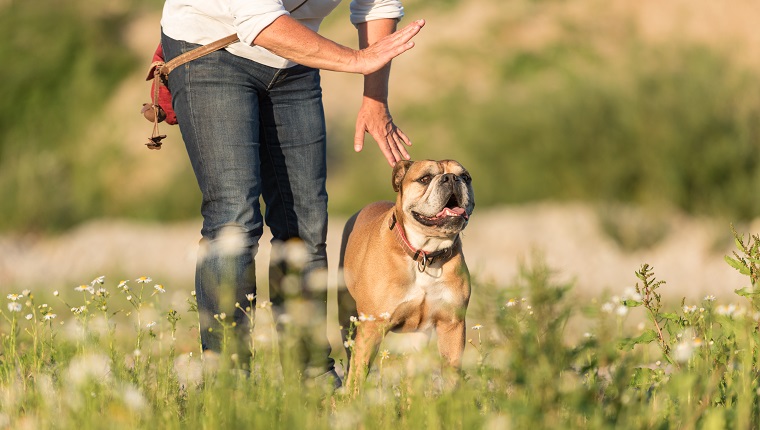One of the main reasons people surrender their dogs to shelters is unwanted or destructive behavior from their dogs. These can include aggression, excessive barking, escaping, chewing and digging, or any number of other behavioral issues.
However, with a bit of training, most dog parents can reduce or eliminate these habits and live peacefully with their pooches. That said, if you’re dealing with aggression issues, it’s usually best to consult a professional canine behaviorist.
Any behavior can become much worse through inadequate training or poor handling. Physical force is never effective and only weakens the bond you’re trying to build.
But for your dog to learn what is and isn’t appropriate in the world you share, you must act as the benevolent leader of your household. Here are a few things to know when dealing with your dog’s unwanted habits.
Understand Unwanted Dog Behavior & How To Approach Training
Many unwanted canine behaviors are born out of instinct, and most arise from either boredom or stress.
It’s important to recognize that these behaviors are innate. When your pup digs up your flowerbeds, they’re not seeking revenge or punishing you for taking away their tennis ball. Dogs simply aren’t programmed that way.
Aggressive behavior, chasing, marking, and resource guarding are modern manifestations of dogs’ early instincts to acquire food and protect their territory and pack. Digging and chewing, on the other hand, are usually the results of boredom. Barking is a little of both.
Jumping up and mouthing are simply examples of one species (dogs) attempting to make a connection using very different forms of communication than another species (humans) understands.
In order to reduce unwanted behaviors, you’ll need to understand your dog’s needs and be an effective leader. Here are a few key ingredients to effective training:
- Set boundaries and be consistent.
- Reinforce good behavior with plenty of treats, toys, and attention.
- Ignore unwanted behavior as much as possible.
- Make sure your dog knows they’re a beloved and important part of the pack.
Preventing Bad Behavior In Puppies

Preventing a bad behavior is always preferable to having to treat it, and early training is key.
Enroll your puppy in obedience classes, and practice with them daily, even after the course ends. Training not only teaches your dog mannerly and useful behaviors, it also hones impulse control and provides essential mental stimulation.
It’s a good idea to add to your pup’s repertoire of tricks and skills throughout their life.
Early socialization is the other key ingredient. Preferably before your dog reaches twelve weeks of age — when the window of opportunity begins to close and dogs start fearing the unfamiliar — expose your pup to as much as possible.
Introduce them to people of all shapes, sizes, and colors, young and old, male and female. Arrange for playdates with dogs of different breeds, maturity levels, and play styles so that they learn good canine manners and play behavior.
Finally, acquaint your dog with a wide variety of sights and sounds, from kids riding skateboards to the toilet flushing to Fourth of July fireworks.
Treating Behavior Problems In Adult Dogs
Some of the most loving, loyal, and intelligent dogs come from shelters where the majority are well past twelve weeks of age. If you’ve missed that window of opportunity for socialization, or a particular behavior already exists, treatment can be very effective.
Providing your dog plenty of mental and physical exercise is crucial to maintaining a well-adjusted dog. It’s also an effective prevention tool.
It’s true: A tired dog is a happy dog, and the more physical and mental stimulation your dog gets, the less likely they’ll be to dig, chew, or escape.
Like humans, dogs are social animals. Making them spend long days alone with nothing to do is not only cruel, it’s an invitation for bad behavior. In the absence of having something to do, your dog will create their own ways to amuse themselves.
If you work all day or are gone for long stretches, consider hiring a dog walker or finding a doggy day care.
Consult The Professionals For Serious Issues

Some cases require the help of a reputable trainer. Physical correction is never appropriate and nearly always makes things worse.
For serious issues such as separation anxiety and aggressive behavior, consult a reputable trainer or behaviorist. In those cases, desensitization is usually the preferred method of treatment.
Essentially, desensitization pairs positive reinforcement — treats, praise, attention — with whatever triggers the bad behavior, thereby creating a new, positive association with the trigger.
In plain English: Your dog barks and lunges — anxious behavior — whenever the neighbor kids whiz by on their bicycles — the trigger. Starting with very limited exposure, desensitization pairs the sight of kids riding bicycles with plenty of treats and praise — the positive reinforcement.
Canine misbehavior is rooted in instinct and intensifies when a dog is bored, stressed, or both. Early training, mental and physical exercise, and plenty of attention go a long way toward both preventing and treating behavior problems.
Has your dog ever had a behavioral problem that you trained away? What tips do you have for other pet parents? Let us know in the comments below!









